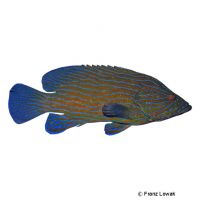Bluelined Hind (Cephalopholis formosa)
| Bluelined Hind Cephalopholis formosa | |
|---|---|
| Name | Bluelined Hind |
| Name Lat. | Cephalopholis formosa |
| Family | Sea Basses |
| Family lat. | Serranidae |
| Order | Perch-likes |
| Order lat. | Perciformes |
| Origin | Indo-West Pacific |
| Habitat | Shallow reefs |
| Diet | Carnivore |
| pH | 8.1-8.4 |
| Hardness | 8-10 °KH |
| Behavior | Aggressive |
| Keeping | Individual |
| Reef Compatible | With caution |
| Care Level | Difficult |
| Life Span | 5-10 years |
| Protection | No |
| Metric Units | |
| Size | 30 cm |
| Temperature | 23-28 °C |
| Salinity | 33-36 ‰ |
| Aquarium | ~ 700 l |
| US Units | |
| Size | 12" |
| Temperature | 73-82 °F |
| Salinity | 1.020-1.025 sg |
| Aquarium | ~ 180 gal |
Distribution and habitat
The distribution area of Cephalopholis formosa is the Indian Ocean and the Western Pacific, from the East African coast via Indonesia to Japan and Australia. They live there in shallow water on coral and rock reefs in 10-30 m depth.
Maintenance
They require a well-structured aquarium with a reef structure that allows for territoriality and at the same time provides sufficient hiding, resting and covering opportunities, with live stones that act like a biological filter and sufficient swimming space. Only lime-rich, heavy metal-free sands, gravels, stones or sea sand of various grain sizes may be used as substrate
Filters, skimmers and heaters are necessary to ensure water quality, as well as pumps to simulate tides, swells and bottom currents. Lighting must correspond to the species-appropriate day-night rhythm of the animals
| Salinity: 33-36 ‰ | pH value: 8.1-8.4 |
| Carbonate hardness: 8-10 °KH | Nitrate content: 2-8 mg/l |
| phosphate content: 0.01-0.1 mg/l | nitrite content: 0.0-0.05 mg/l |
For salinity, an average value should be aimed for, which may only vary slightly by +/- 0.5 ‰. Ammonia and ammonium must not be measurable. Special attention must be paid to constantly good water quality.
Diet
They are active at twilight, loyal lurkers and not very choosy about food. The feed change succeeds without problems. The food supply should consist of a commercially available, vitamin-enriched frozen food mix or a combination of live or frozen fish, shrimp and crabs as well as crab, mussel and squid meat. In addition, high-quality dry food rich in vitamins and minerals, e.g. in tablet form, should be offered.
Regular and varied feeding promotes health and increases resistance.
Behaviour and compatibility
They are territorial and incompatible both intraspecies and with other groupers. They can be well socialized with other fish that are not considered prey. Especially recommended is community keeping with cleaner wrasses, which they clean of parasites and dead skin.
Sex dimorphism
They are protogynous hermaphrodites, i.e. most males develop from functional females, but hermaphrodite forms (males and females simultaneously) are also possible. External sexual characteristics are not known.
Reproduction and breeding
There are no known reports of successful breeding in the aquarium.
Important
They can vary in color from dark brown to yellowish brown to dark blue, depending on location. Administration of vitamins can prevent the "goggle eyes" that are common in groupers. As coral reef dwellers, they should not be maintained in a fish-only aquarium
If different species are kept together, care should be taken to ensure that the fish match each other in terms of water quality and temperature requirements and social behavior, and that the setup meets the needs of all species kept together. New fish to be introduced must be acclimated slowly to the water in the aquarium
Further literature can be found in your pet store.
References
Text: Werner Winter; Image: Franz Lowak
Source: KUITER, DEBELIUS (2007): Atlas der Meeresfische: Die Fische an den Küsten der Weltmeere, Kosmos Verlag; BAENSCH & PATZNER (1998): Meerwasser Atlas Bd. 7, Mergus Verlag; ENGELMANN (2005): Zootierhaltung - Tiere in menschlicher Obhut: Fische, Verlag Harri Deutsch
- Gemäß § 21 Abs. 5 Tierschutzgesetz idgF
